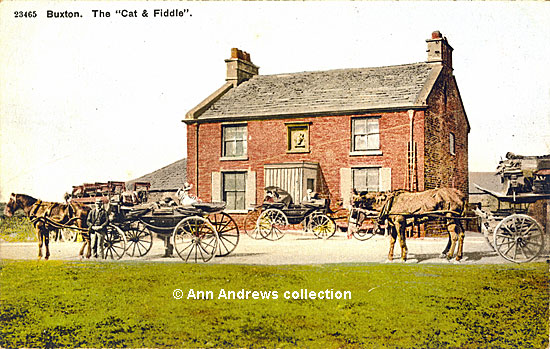|
The Cat and Fiddle Inn is one of those places everyone
knows about, in part because it is so high above sea
level and has stunning views. It is also renowned for
the severe winters and deep snow it sometimes endures, when
the road is impassable and the inn is cut off. The top postcard
shows the inn surrounded by deep snowdrifts; various
innkeepers will have provided shelter for many a stranded
traveller over the years. In January 1949, for example, a
Buxton postman drove to the Cat and Fiddle to make his morning
delivery only to become stuck, along with
eight other vehicles, in drifting snow. A snow plough
eventually came to the rescue and the postie was taken home
during the evening[1].
The inn has long attracted visitors. The following has been
extracted from a 1912 directory about Buxton: "two miles
further on [from Axe Edge] is the "Cat and Fiddle," a
wayside public house, much frequented by visitors on account
of the extensive views to be obtained in the neighbourhood
; wagonettes run to both these places from Buxton several times
daily[2]".
Wagonettes and carriages can be seen in the early twentieth
century card, which shows a considerably smaller inn than the
building in the top image. The sign of a cat playing a fiddle
is above the main entrance, at first floor level, on both pictures.
Over the years there were endless theories put forward about
the inn's name, including that it derived from the nursery
rhyme beginning with "Hey Diddle Diddle, The Cat and the
Fiddle" ...
An electric tramway from Chapel en le Frith, passing through
Buxton and then up to the Cat and Fiddle, was discussed in
1902 but nothing seems to have come of the idea[3].
 |
Early twentieth century.
A stage coach can be seen behind the carriage on the left. |
When the inn was threatened with closure in 1918 both Frederic
Arkwright and the Duke of Devonshire commented in
the press. Miss Frances Wilmot of Stafford Street, Derby then
wrote that "the inn was built, or was caused to be built,
by Mr. and Mrs. Wood, uncle and aunt to my mother, the late
Mrs. Woollett Wilmot. Mr. and Mrs. Wood were living at Westbrook,
Macclesfield, and were much distressed by accounts of people
being lost, and sometimes perishing, on the moors between Macclesfield
and Buxton. My mother often referred to this, and I believe
it to have been real fact. Mrs. Wood was a daughter of Mr.
Ryle, banker in Macclesfield..."[4].
A gentleman called Horace Weir confirmed this newly published
information, but added to the debate by stating his own research
pointed to it having been Mrs. Wood's father who built the
inn around 1800[5].
One of the contributors to Mee's "Derbyshire"
wrote "A fine moorland walk of five miles from Buxton
takes us to the Cat and Fiddle in Cheshire, one of the highest
inns in England, 1700 feet above the sea, with views over the
great plain of Cheshire, with the Mersey on the horizon, into
Staffordshire and Lancashire, and to the Welsh Hills[6]".
The inn is next to the A537 which runs between Buxton in Derbyshire
and Macclesfield in Cheshire; these days the road is sadly
renowned for the number of accidents, mostly involving motor
cyclists.
|
References:
[1] "Nottingham Journal",
5 January 1949. Post Van was Marooned.
[2] Kelly's Directory of Derbyshire,
1912, Buxton entry.
[3] Mee, Arthur (ed.) (1937) "Derbyshire:
The Peak Country",The King's England Series, Hodder
and Stoughton Limited, London.
[4] "Derby Daily Telegraph",
16 July 1918. Correspondence. "The Cat and Fiddle".
[5] "Derby Daily Telegraph",
18 July 1918. Horace Weir's letter adding to
what Miss Wilmot had said. Mr. Ryle was the father of the bishop
of Liverpool.
[6] "Sheffield Daily Telegraph",
8 December 1902, "Belper News", 12 December
1902 and other newspapers in the surrounding area discussed
the proposed tram, but all the papers were opposed to the idea.
|